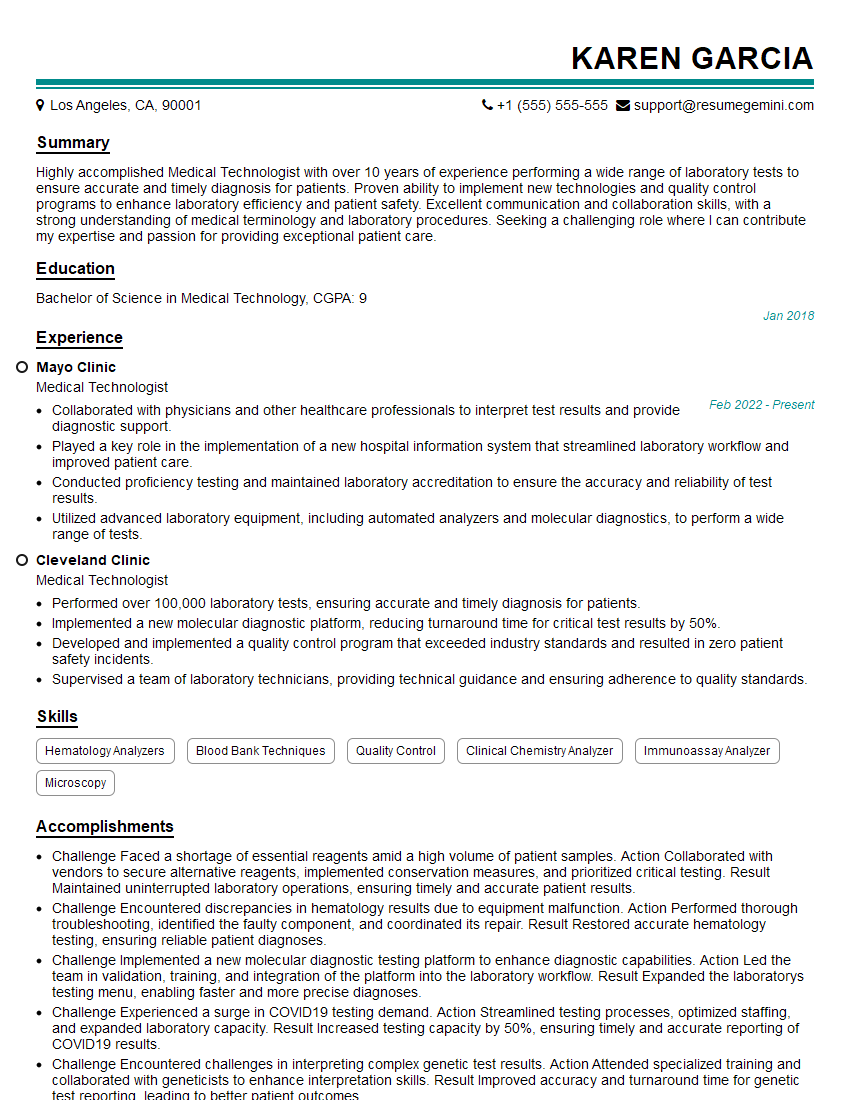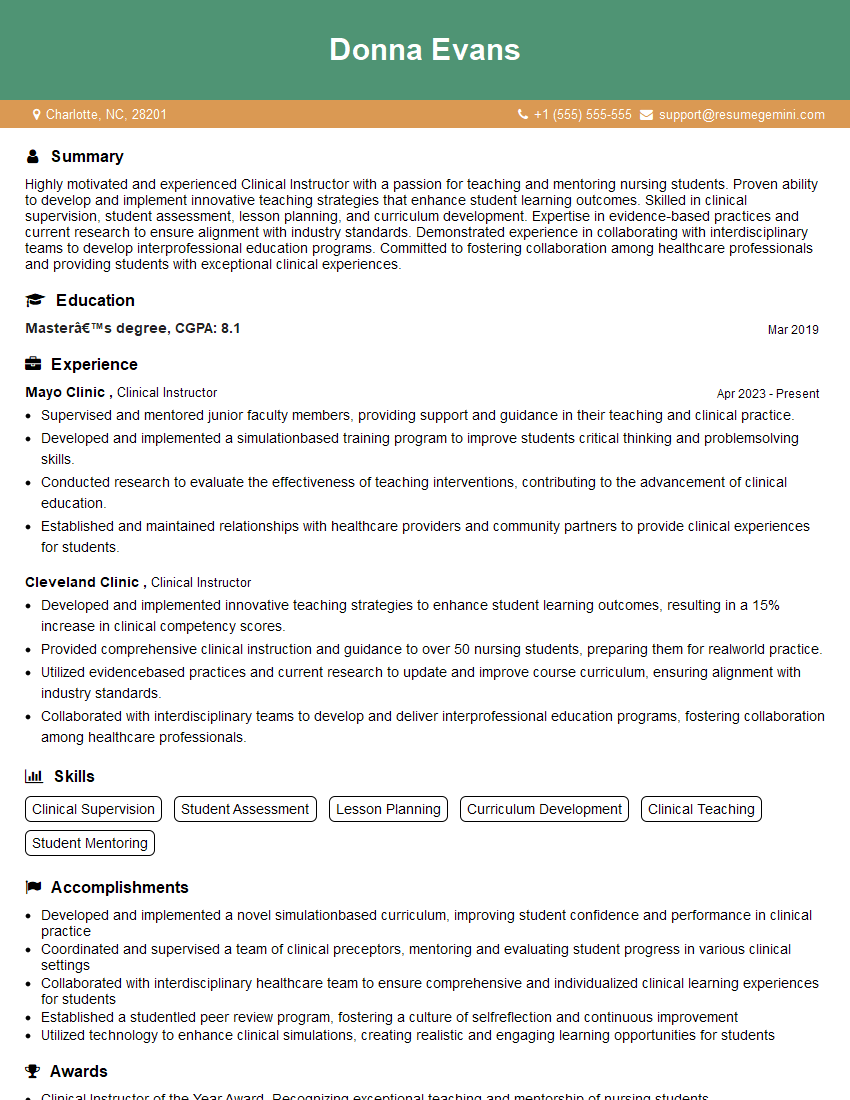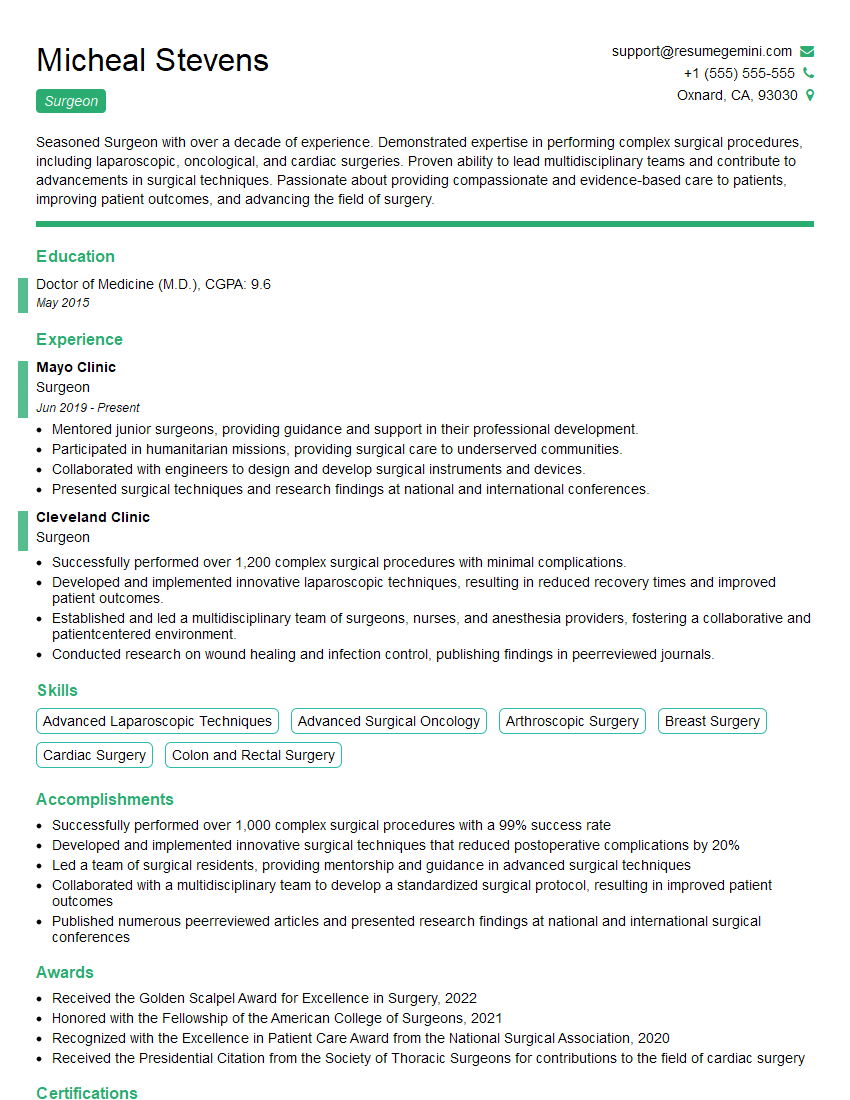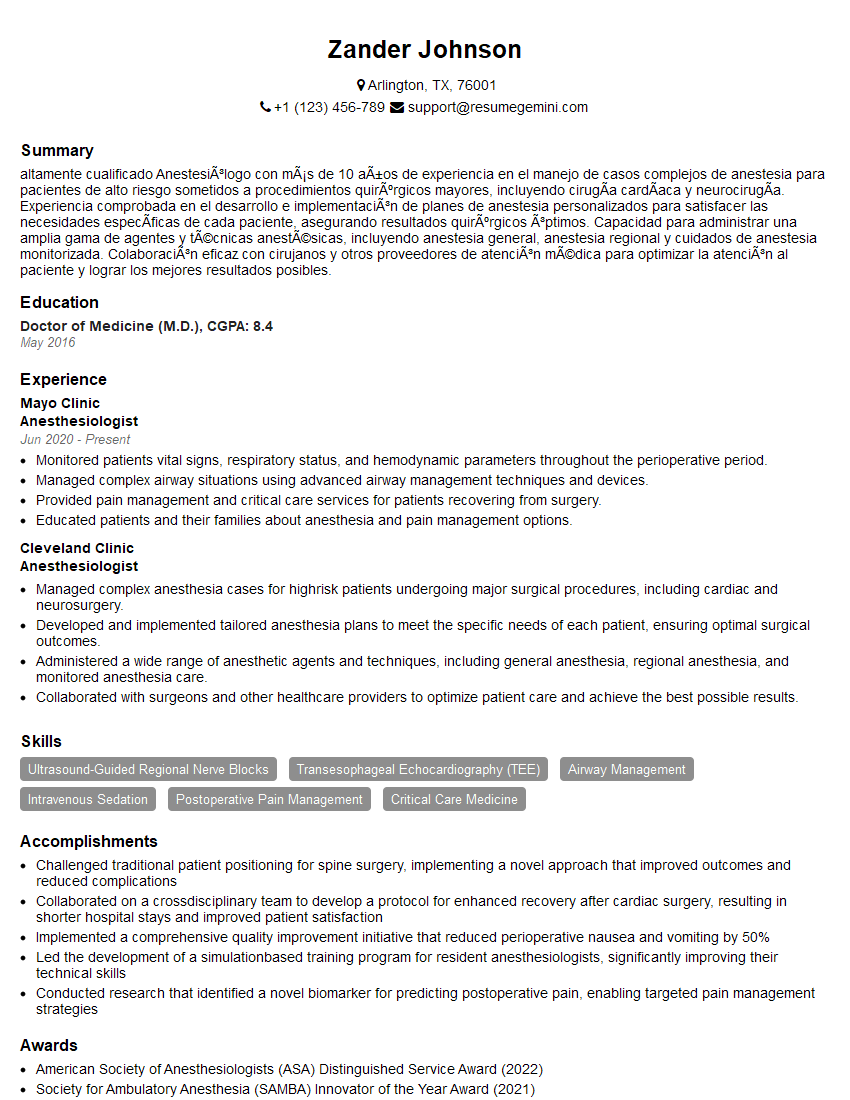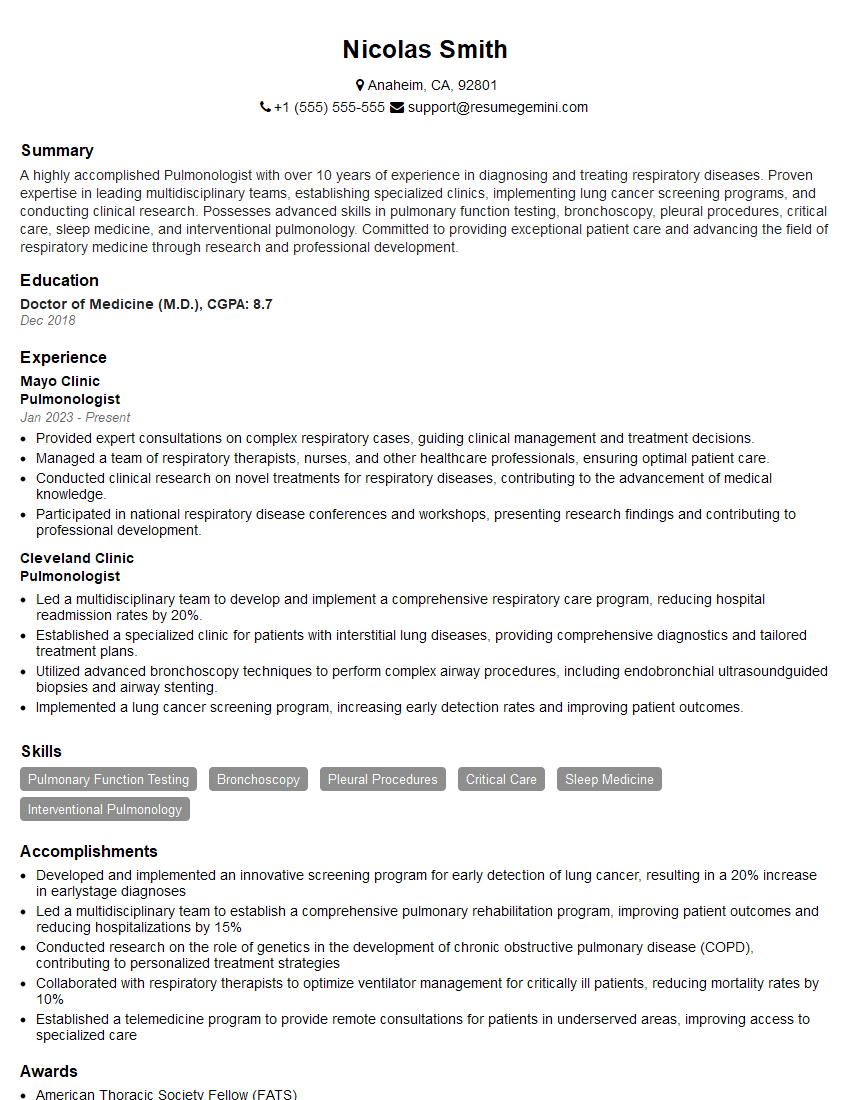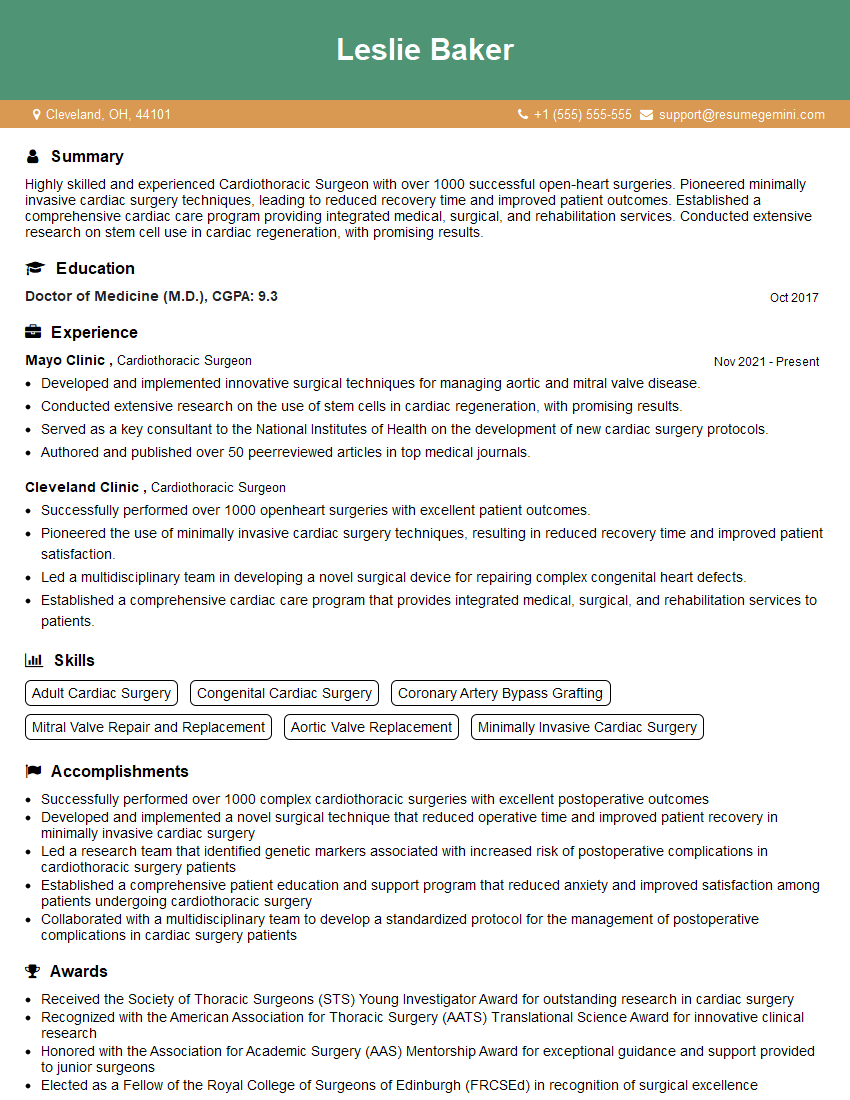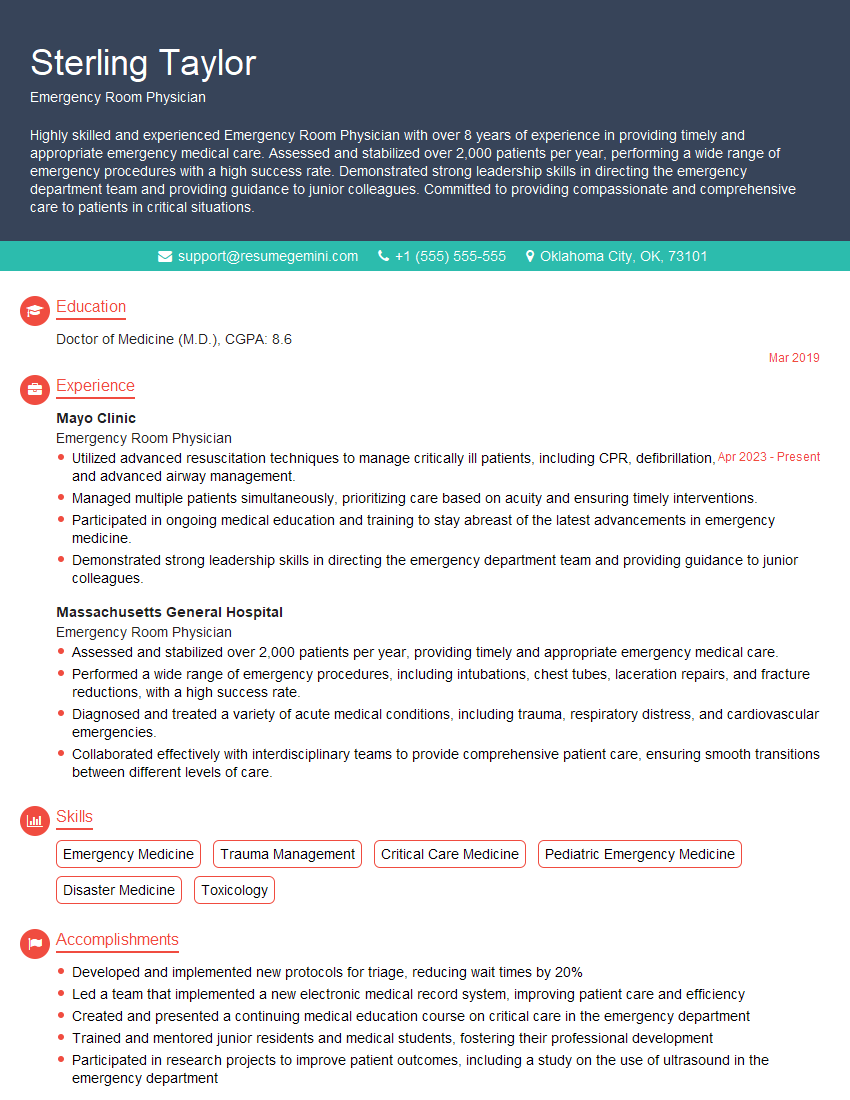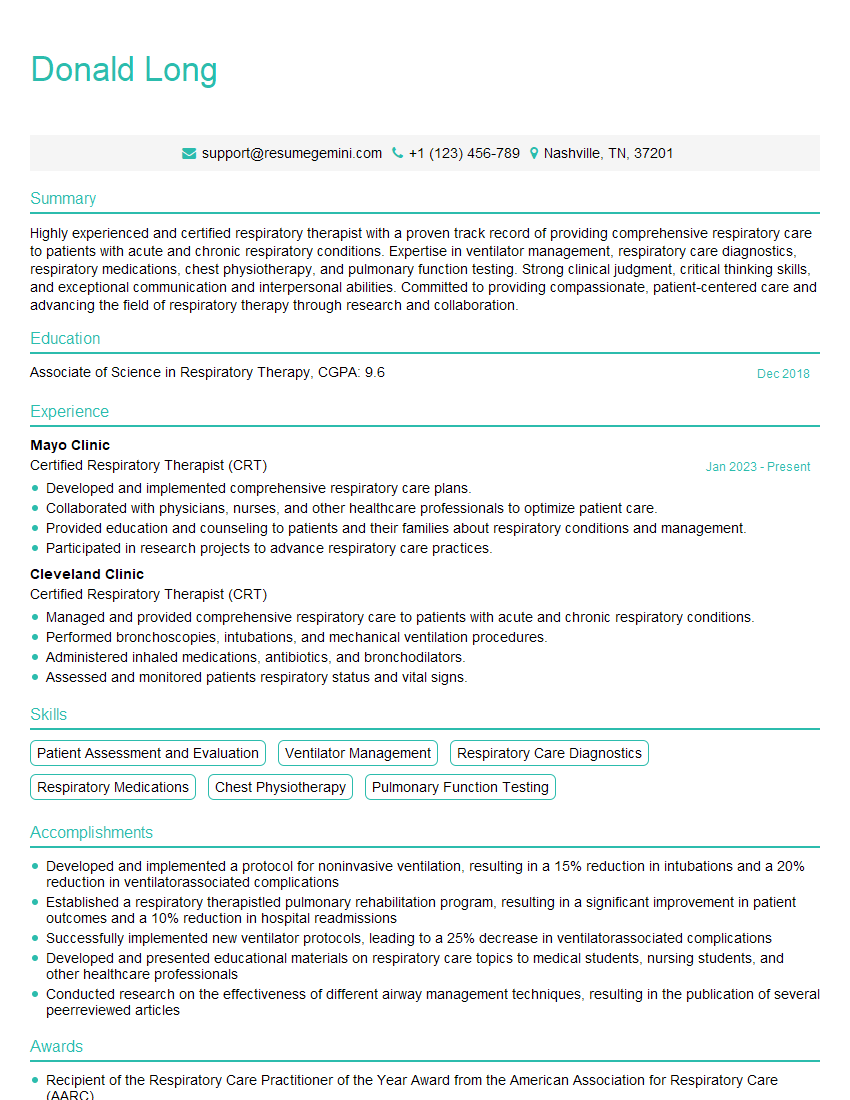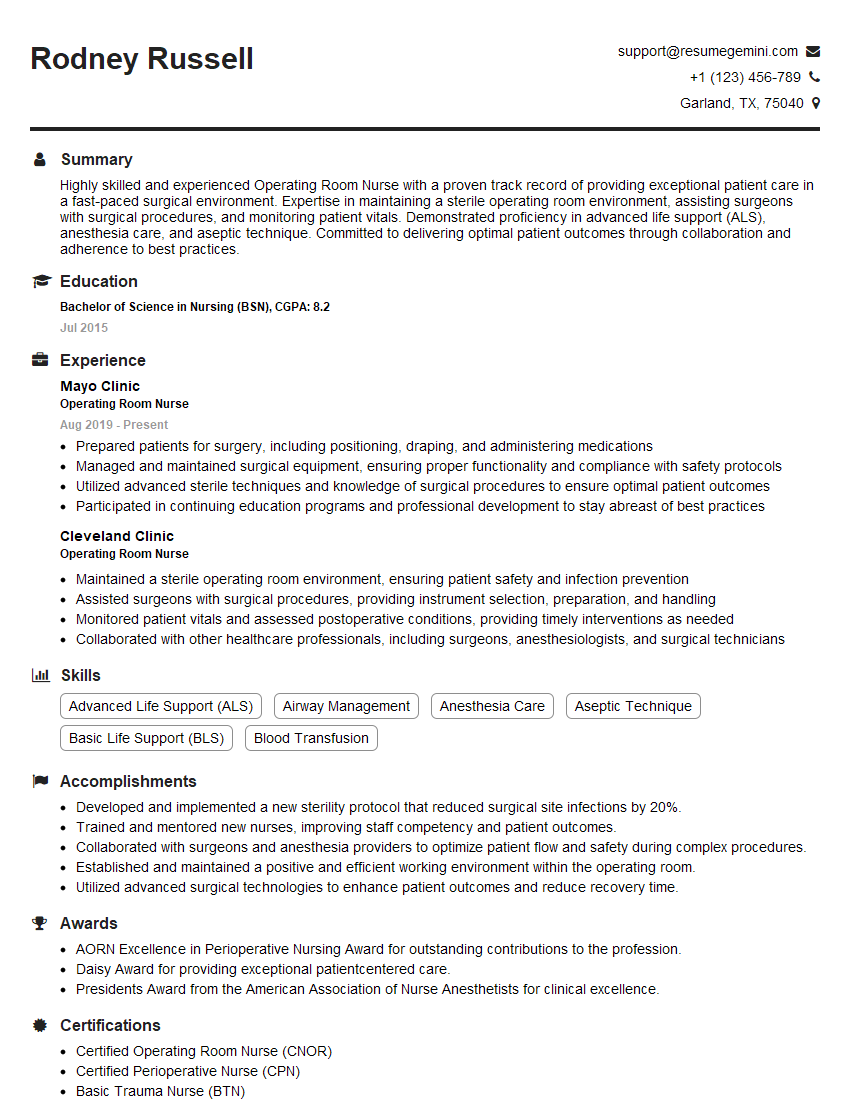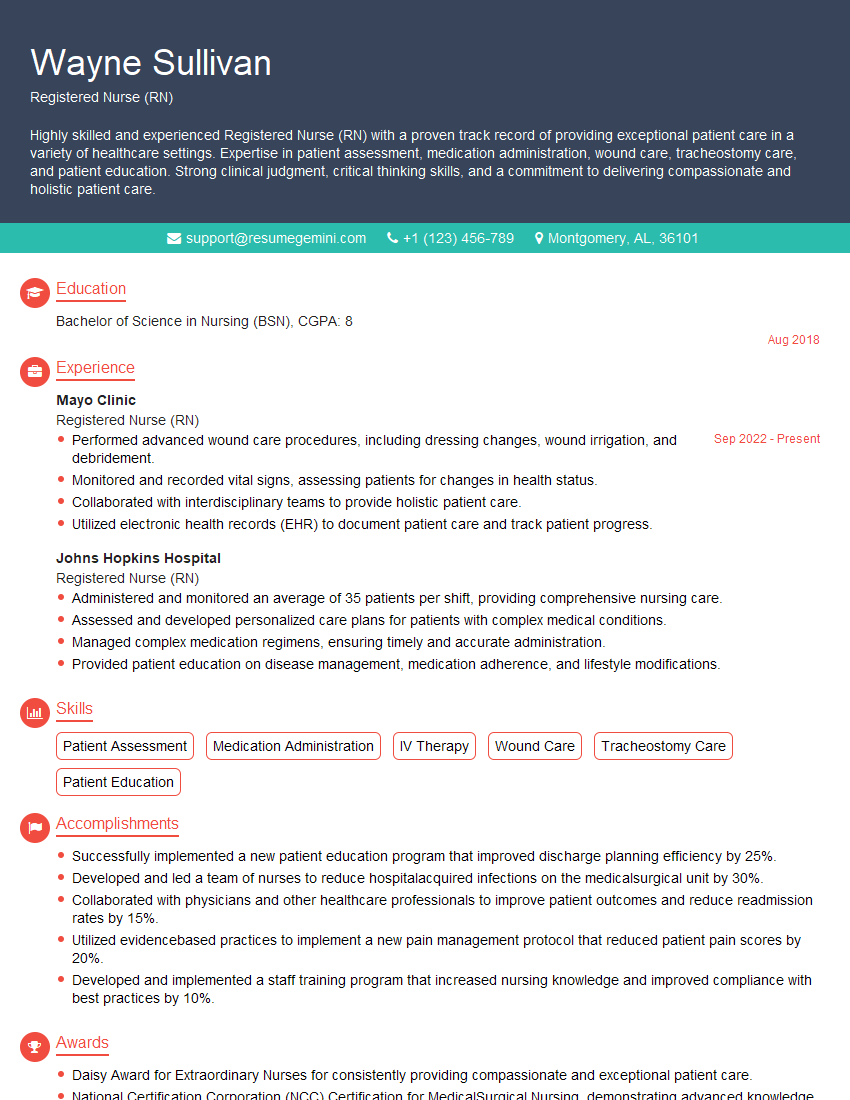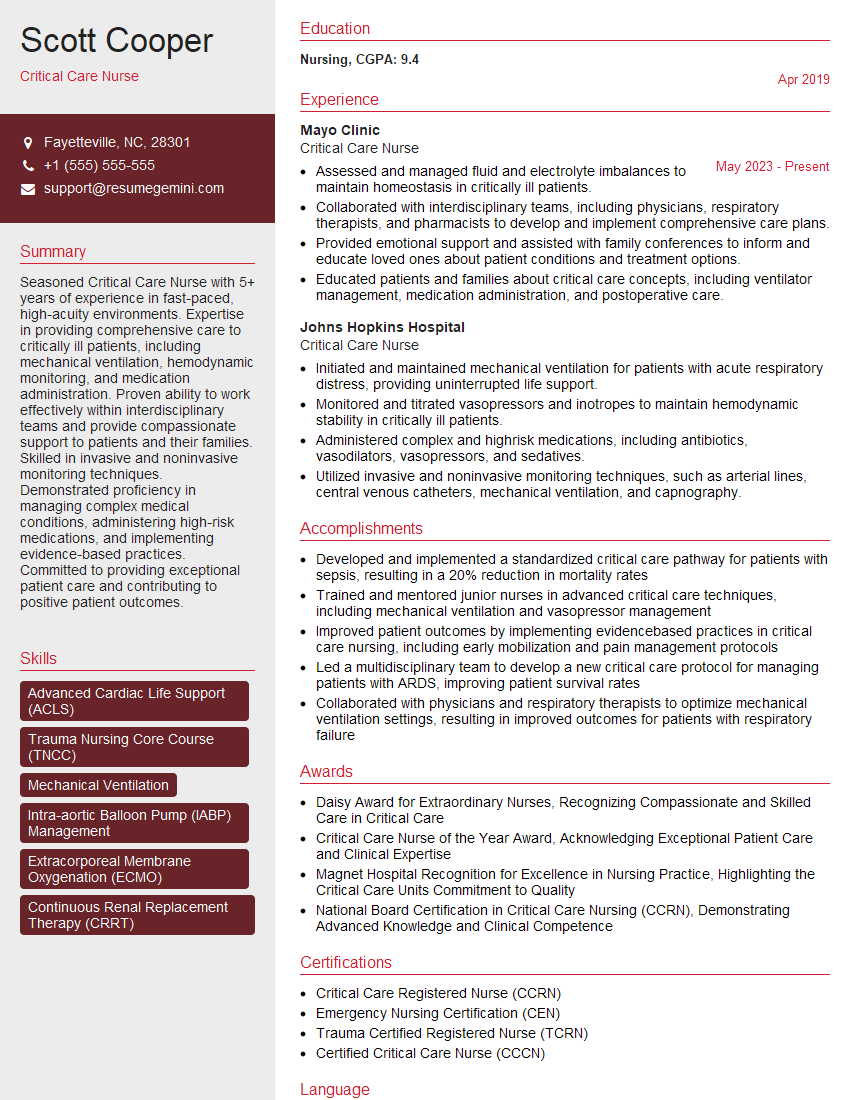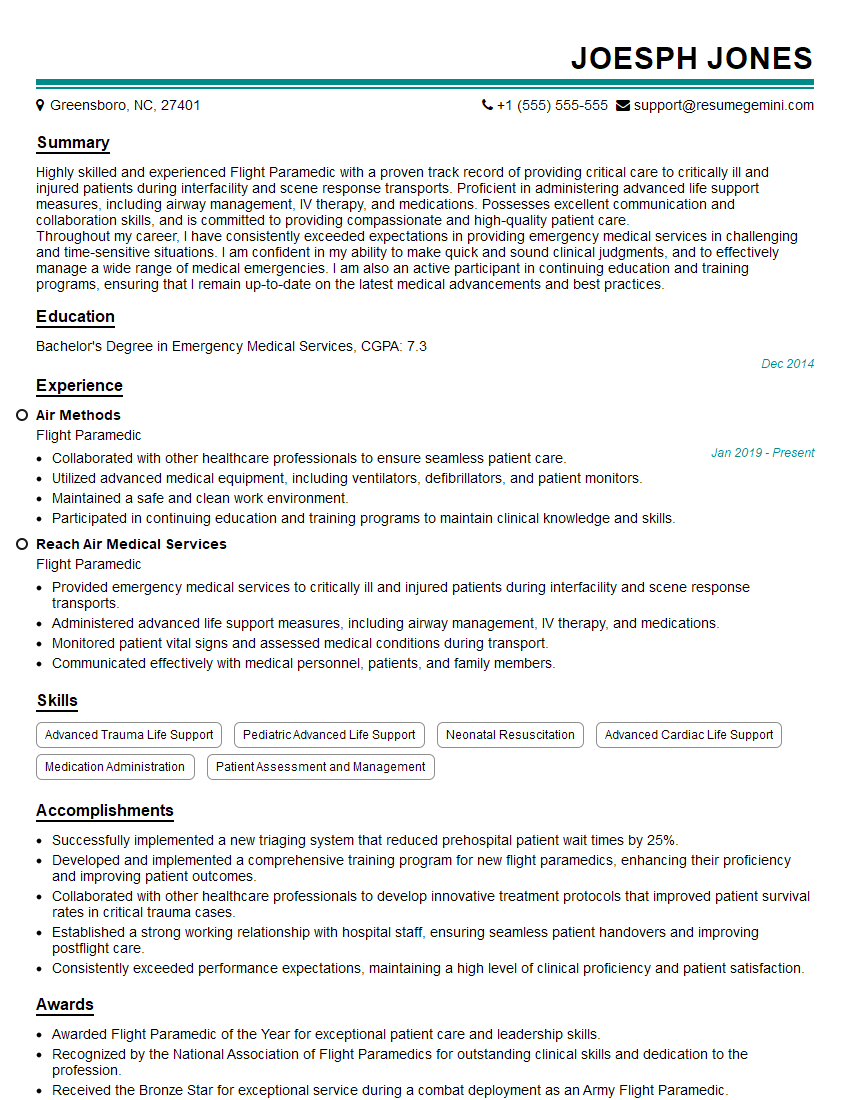Are you ready to stand out in your next interview? Understanding and preparing for Oximetry and Capnography interview questions is a game-changer. In this blog, we’ve compiled key questions and expert advice to help you showcase your skills with confidence and precision. Let’s get started on your journey to acing the interview.
Questions Asked in Oximetry and Capnography Interview
Q 1. Explain the principles of pulse oximetry.
Pulse oximetry is a non-invasive method for monitoring the oxygen saturation of arterial blood (SpO2). It works by using a sensor, typically placed on a fingertip or earlobe, that emits two wavelengths of light – red and infrared. These lights pass through the tissue, and the sensor measures the amount of light absorbed. Oxygenated and deoxygenated hemoglobin absorb these wavelengths differently. By analyzing the difference in absorption, the device calculates the percentage of hemoglobin saturated with oxygen.
Think of it like this: imagine shining a flashlight through a jar of red and blue marbles. If most of the marbles are red (oxygenated hemoglobin), more red light will pass through. The sensor uses this difference in light absorption to determine the proportion of oxygenated to deoxygenated hemoglobin.
Q 2. What are the limitations of pulse oximetry?
While pulse oximetry is a valuable tool, it has limitations. It doesn’t directly measure arterial blood gases (like PaO2, partial pressure of oxygen in arterial blood), only the percentage of hemoglobin carrying oxygen. Therefore, it can be inaccurate in certain situations.
- Anemias: In patients with anemia, even if the SpO2 is high, the actual amount of oxygen carried might be low due to reduced hemoglobin concentration.
- Dyshemoglobinemias: Conditions like carbon monoxide poisoning interfere with the measurement because carboxyhemoglobin absorbs light similarly to oxyhemoglobin, leading to falsely elevated SpO2 readings.
- Motion artifact: Patient movement can affect the accuracy of the readings.
- Poor perfusion: If blood flow to the extremity is compromised (e.g., hypothermia, vasoconstriction), the reading might be inaccurate or absent.
- Nail polish, pigments: Dark nail polish or pigments can interfere with light transmission.
It’s crucial to remember that pulse oximetry is a screening tool and should be used in conjunction with other clinical assessments and blood gas analysis for a complete picture of a patient’s oxygenation status.
Q 3. How does pulse oximetry differ from capnography?
Pulse oximetry and capnography are both valuable monitoring tools, but they measure different aspects of respiratory function. Pulse oximetry measures the percentage of hemoglobin saturated with oxygen in arterial blood (SpO2), providing an indirect assessment of oxygenation. Capnography, on the other hand, directly measures the partial pressure or concentration of carbon dioxide (CO2) in exhaled breath (EtCO2), providing real-time information about ventilation and CO2 elimination.
In essence, pulse oximetry tells us how much oxygen the blood is carrying, while capnography tells us how effectively the body is eliminating carbon dioxide, a byproduct of metabolism. They complement each other, offering a more comprehensive understanding of a patient’s respiratory status.
Q 4. Describe the different types of capnography.
There are several types of capnography, primarily differing in their method of CO2 detection:
- Mainstream capnography: The sensor is placed directly in the breathing circuit, analyzing exhaled gas continuously. This provides accurate and real-time measurements.
- Sidestream capnography: A small sample of exhaled gas is aspirated from the breathing circuit and transported to a remote sensor for analysis. This method is less invasive but can have a slight delay in readings.
Within these main types, there are variations in the technology used for CO2 detection, such as infrared spectroscopy and electrochemical methods. The choice of capnography type depends on the clinical setting and specific needs.
Q 5. Explain the waveforms seen in capnography.
The capnography waveform displays the concentration of CO2 over time during each breath cycle. A normal waveform has a characteristic shape with several phases:
- Phase I: Baseline – represents the CO2 concentration before exhalation.
- Phase II: Expiratory upstroke – a rapid increase in CO2 as exhaled gas from the dead space reaches the sensor.
- Phase III: Expiratory plateau – relatively flat representing the alveolar CO2 concentration.
- Phase IV: Inspiratory downstroke – a rapid decrease in CO2 as fresh gas enters the lungs.
Deviations from this normal waveform can indicate various respiratory problems, such as airway obstruction, ventilation-perfusion mismatch, and rebreathing.
Imagine a mountain. Phase I is the valley before the climb. Phase II is the steep ascent. Phase III is the flat summit. Phase IV is the descent back down.
Q 6. What are the normal ranges for SpO2 and EtCO2?
Normal ranges for SpO2 and EtCO2 are:
- SpO2: 95-100% on room air. Values below 90% are generally considered hypoxemia (low blood oxygen).
- EtCO2: 35-45 mmHg. Values outside this range can indicate hypoventilation (low EtCO2) or hyperventilation (high EtCO2), or other respiratory issues.
These are general ranges, and individual values may vary based on factors like age, activity level, and underlying health conditions.
Q 7. Interpret this SpO2 reading: 92% on room air.
An SpO2 reading of 92% on room air indicates mild hypoxemia. While not critically low, it suggests that the patient’s oxygen saturation is below the ideal range. Further investigation is warranted to determine the underlying cause. This could involve checking the patient’s respiratory rate and effort, auscultating the lungs, and potentially obtaining arterial blood gases to measure PaO2. The patient may benefit from supplemental oxygen.
It’s important to remember that context is critical. A 92% SpO2 in a healthy individual at high altitude might be normal, while the same reading in a post-operative patient could be a significant concern.
Q 8. Interpret this EtCO2 reading: 55 mmHg.
An EtCO2 reading of 55 mmHg is significantly elevated. Normal EtCO2 levels typically range from 35-45 mmHg. An EtCO2 of 55 mmHg indicates hypercapnia, meaning there’s excessive carbon dioxide in the exhaled breath. This suggests that the patient is not adequately eliminating CO2, which can have serious implications.
Several factors can contribute to this: inadequate ventilation (e.g., respiratory depression from opioids or neuromuscular disease, airway obstruction), increased CO2 production (e.g., fever, sepsis, increased metabolic rate), or a problem with the capnograph itself (e.g., a leak in the system).
Think of it like this: Your lungs are like a pump removing waste (CO2) from your body. If the pump isn’t working efficiently, or if it’s producing more waste than it can remove, the waste builds up (high EtCO2).
In a clinical setting, such a reading would warrant immediate investigation. The healthcare provider should assess the patient’s respiratory status, lung sounds, and consider measures to improve ventilation, such as assisted ventilation or treatment of the underlying cause.
Q 9. What are the causes of low SpO2?
Low SpO2, or hypoxemia, indicates low oxygen saturation in the arterial blood. Several factors can contribute to this. It’s crucial to remember that a low SpO2 reading is a symptom, not a diagnosis – you need to find the underlying cause.
- Respiratory Issues: Hypoventilation (slow or shallow breathing), airway obstruction (e.g., mucus plug, foreign body), pneumonia, pulmonary edema (fluid in the lungs), pneumothorax (collapsed lung), pulmonary embolism (blood clot in the lung).
- Cardiac Issues: Congestive heart failure (CHF), heart valve problems, cardiac arrhythmias (irregular heartbeats).
- Hemoglobin Problems: Anemia (low red blood cell count), carbon monoxide poisoning (CO binds to hemoglobin more strongly than oxygen), methemoglobinemia (abnormal hemoglobin form).
- Other Causes: Severe hypothermia, high altitude, certain medications, severe shock.
Imagine your blood as a delivery truck carrying oxygen. A low SpO2 means the truck isn’t carrying or delivering enough oxygen to the body’s tissues.
Q 10. What are the causes of high EtCO2?
High EtCO2, as mentioned before, is hypercapnia. Several causes, similar to what results in a high EtCO2 reading, can lead to this:
- Hypoventilation: This is the most common cause. Reduced respiratory rate or depth leads to inadequate CO2 removal. This can be due to respiratory depression (from medications, brain injury, etc.), neuromuscular weakness, or airway obstruction.
- Increased CO2 Production: Conditions like fever, sepsis, severe acidosis, and malignant hyperthermia increase metabolic rate and thus CO2 production.
- Rebreathing: A leak in the breathing circuit of a ventilator or inadequate ventilation can cause rebreathing of exhaled CO2, artificially elevating the EtCO2 reading.
- Equipment Malfunction: Problems with the capnograph itself can lead to inaccurate readings.
Think of this as a traffic jam on the CO2 removal highway. If the traffic is slowed (hypoventilation) or there’s too much traffic (increased production), CO2 backs up.
Q 11. How do you troubleshoot a malfunctioning pulse oximeter?
Troubleshooting a malfunctioning pulse oximeter involves a systematic approach:
- Check the Sensor and Site: Ensure the sensor is properly attached, the site is clean and dry, and there’s good circulation. Poor perfusion (low blood flow) can lead to inaccurate readings. Try repositioning the sensor or selecting a different site (e.g., finger, toe, earlobe).
- Check the Oximeter Itself: Examine the oximeter for any visible damage, check the battery level, and make sure it’s properly connected. Try calibrating the device if the instructions permit.
- Check for Interference: Strong ambient light, movement artifacts, or nearby electromagnetic interference can affect accuracy. Reduce or eliminate these sources.
- Verify with Another Device: If possible, compare the SpO2 reading with another pulse oximeter or by using a different measurement method (e.g., arterial blood gas analysis).
- Consider Patient Factors: Nail polish, excessive pigmentation, or cold extremities can interfere. Remove nail polish or consider an alternate measurement site.
Always remember patient safety; if you have any doubt about the accuracy of the reading, seek a second opinion or alternative method of oxygen saturation assessment.
Q 12. How do you troubleshoot a malfunctioning capnograph?
Troubleshooting a capnograph involves several steps:
- Check Connections: Ensure all connections (from the patient to the monitor) are secure and free from leaks. Leaks will lead to inaccurate or absent readings.
- Check the Sampling Line: Inspect the sampling line for kinks, obstructions, or moisture build-up. These can interfere with proper sampling of exhaled CO2.
- Check the Sensor: Make sure the sensor is clean and properly calibrated (following the manufacturer’s guidelines). A dirty sensor will give inaccurate readings.
- Check the Monitor Itself: Verify that the capnograph monitor is turned on and functioning correctly. Check the power supply and screen display.
- Check for Air Leaks in the Breathing Circuit: If the patient is ventilated, a leak in the breathing circuit will significantly affect the EtCO2 reading.
- Check for Patient Factors: Certain patient factors, such as bronchospasm, may affect the reading. The clinician should evaluate the patient for the presence of these.
If the problem persists, consult the manufacturer’s troubleshooting guide or seek technical support.
Q 13. What are the clinical implications of hypoxemia?
Hypoxemia, or low blood oxygen, has significant clinical implications. The severity depends on the level of oxygen desaturation and the duration. Consequences can range from mild symptoms to life-threatening complications:
- Mild Hypoxemia: May be asymptomatic or cause subtle symptoms such as shortness of breath (dyspnea), fatigue, headache, or dizziness.
- Moderate to Severe Hypoxemia: Can lead to more serious symptoms such as confusion, cyanosis (bluish discoloration of the skin), tachycardia (rapid heart rate), tachypnea (rapid breathing), and altered mental status.
- Severe, Prolonged Hypoxemia: Can result in organ damage, including the heart, brain, kidneys, and lungs. This can lead to acute respiratory distress syndrome (ARDS), cardiac arrhythmias, myocardial infarction (heart attack), stroke, and even death.
Imagine your body’s cells as a factory; they need oxygen to function properly. Hypoxemia starves the factory, leading to decreased productivity and potential damage.
Q 14. What are the clinical implications of hypercapnia?
Hypercapnia, or elevated carbon dioxide levels in the blood, also carries significant clinical implications:
- Mild Hypercapnia: May cause drowsiness, headache, and confusion.
- Moderate to Severe Hypercapnia: Can lead to more significant neurological effects, such as disorientation, lethargy, stupor, coma, and even respiratory arrest. It can also cause increased intracranial pressure.
- Chronic Hypercapnia: Can cause long-term changes in blood vessel function and damage to the respiratory system.
Think of CO2 as a waste product. Hypercapnia means your body is building up too much waste. The brain is especially sensitive to high CO2 levels, leading to the neurologic symptoms.
Q 15. Explain the difference between hypoxemia and hypoxia.
While both relate to insufficient oxygen in the body, hypoxemia and hypoxia differ significantly. Hypoxemia specifically refers to low levels of oxygen in the blood, measurable by pulse oximetry. Think of it as a blood oxygen deficiency. Hypoxia, on the other hand, is a broader term encompassing low oxygen levels in the body tissues. It’s the result of insufficient oxygen delivery to the tissues, regardless of the cause. Hypoxemia is a common cause of hypoxia, but hypoxia can also stem from problems with blood flow, impaired tissue oxygen utilization, or even poisoning. For example, a patient might have hypoxemia due to pneumonia, leading to hypoxia in their lung tissues and ultimately other organs if left untreated.
Career Expert Tips:
- Ace those interviews! Prepare effectively by reviewing the Top 50 Most Common Interview Questions on ResumeGemini.
- Navigate your job search with confidence! Explore a wide range of Career Tips on ResumeGemini. Learn about common challenges and recommendations to overcome them.
- Craft the perfect resume! Master the Art of Resume Writing with ResumeGemini’s guide. Showcase your unique qualifications and achievements effectively.
- Don’t miss out on holiday savings! Build your dream resume with ResumeGemini’s ATS optimized templates.
Q 16. Explain the difference between hypercapnia and hypocapnia.
Hypercapnia means elevated levels of carbon dioxide (CO2) in the blood, while hypocapnia signifies abnormally low levels. These conditions are directly assessed using capnography, which measures the CO2 concentration in exhaled breath. Hypercapnia often indicates inadequate ventilation, potentially caused by respiratory depression, airway obstruction, or lung disease. Imagine a patient with severe COPD – their impaired gas exchange might lead to hypercapnia. Conversely, hypocapnia can be seen in conditions like hyperventilation syndrome, where rapid breathing excessively removes CO2 from the body. A patient experiencing a panic attack, for example, might hyperventilate, resulting in hypocapnia.
Q 17. What are the potential artifacts that can affect pulse oximetry readings?
Pulse oximetry, while invaluable, is prone to artifacts. These can significantly affect readings and lead to misinterpretations. Common artifacts include:
- Motion artifact: Patient movement, especially shaking or shivering, can disrupt the sensor’s ability to accurately measure oxygen saturation.
- Poor perfusion: Conditions like hypotension or hypothermia can reduce blood flow to the periphery, leading to inaccurate SpO2 readings.
- Nail polish or artificial nails: Pigmented substances interfere with light transmission, causing falsely low readings.
- Ambient light: Bright external light sources can also interfere with the sensor’s readings.
- Methylene blue: This medication can interfere with oximetry readings.
- Dyshemoglobins: Abnormal hemoglobin forms such as carboxyhemoglobin (COHb) or methemoglobin (MetHb) can cause falsely elevated or depressed SpO2 readings, respectively. This highlights the importance of using oximetry with clinical judgment.
Clinicians must carefully consider potential artifacts when interpreting SpO2 data. For example, observing a patient with cold hands might lead us to warm the extremities before relying on a single SpO2 reading.
Q 18. What are the potential artifacts that can affect capnography readings?
Capnography readings, too, are susceptible to artifacts. Some key examples include:
- Air leaks: Leaks in the breathing circuit can lead to falsely low or absent end-tidal CO2 readings.
- Improper sensor placement: Incorrect placement of the capnograph sensor can yield inaccurate measurements.
- Excessive dead space: Increased dead space ventilation, as in the case of bronchospasm or a kinked endotracheal tube, can cause a lower-than-expected ETCO2.
- Patient esophageal intubation: In this dangerous scenario, the ET tube is in the esophagus rather than the trachea; capnography would usually not detect CO2.
- Malfunction of the capnograph machine: Calibration errors and equipment malfunctions can lead to significant inaccuracy.
Recognizing these artifacts is crucial to accurately assessing ventilation status. For instance, observing a sudden drop in ETCO2 despite no changes in the ventilator settings warrants immediate investigation for potential leaks or disconnections.
Q 19. Describe the role of oximetry and capnography in the management of patients with respiratory distress.
Oximetry and capnography are essential tools for managing respiratory distress. Pulse oximetry provides continuous monitoring of oxygen saturation (SpO2), helping assess the adequacy of oxygenation. A falling SpO2 indicates worsening hypoxemia, a vital sign demanding immediate attention. Capnography measures end-tidal carbon dioxide (EtCO2), reflecting the effectiveness of ventilation. A rising EtCO2, for example, suggests increasing carbon dioxide retention which signifies inadequate ventilation. By monitoring these parameters, clinicians can quickly identify patients at risk, assess the severity of respiratory compromise, and adjust treatment strategies accordingly. Both parameters give real-time physiological feedback, guiding treatment decisions and minimizing the risk of further complications.
Q 20. How do you use oximetry and capnography data to guide ventilation strategies?
Oximetry and capnography data are pivotal in guiding ventilation strategies, particularly in mechanically ventilated patients. A low SpO2 necessitates adjustments to the FiO2 (fraction of inspired oxygen) or PEEP (positive end-expiratory pressure) to enhance oxygenation. Similarly, a high EtCO2 suggests inadequate ventilation, potentially requiring adjustments to the tidal volume, respiratory rate, or inspiratory pressure. A low ETCO2, however, can also be critical and can hint at significant problems such as a leak, disconnection or poor patient effort. These parameters help achieve the treatment goal of maintaining adequate oxygenation and ventilation in a precise manner, minimizing complications and improving patient outcomes.
For instance, a patient with acute respiratory distress syndrome (ARDS) might exhibit low SpO2 despite high FiO2. Capnography would help assess if the problem lies in oxygenation or ventilation, guiding decisions about PEEP or ventilator settings.
Q 21. Explain the relationship between oxygen saturation and carbon dioxide levels.
While not directly proportional, oxygen saturation (SpO2) and carbon dioxide levels (EtCO2) are intricately related in respiratory physiology. Effective ventilation ensures adequate CO2 removal and oxygen uptake. Therefore, usually, improved ventilation (lower EtCO2) leads to better oxygenation (higher SpO2). However, it’s crucial to understand that this is not always a simple linear relationship. For instance, a patient might have good ventilation (low EtCO2) but still exhibit low SpO2 due to underlying lung pathology such as pulmonary edema or shunt. Similarly, a patient with a shunt might have a high EtCO2, even if ventilation is being managed mechanically; This is because blood is bypassing the ventilated alveoli. Therefore, interpreting SpO2 and EtCO2 data requires considering the overall clinical picture. Clinicians must carefully evaluate other variables like respiratory effort, lung sounds, and chest X-ray findings to develop a complete understanding of the patient’s respiratory status.
Q 22. What are the safety precautions associated with the use of pulse oximeters and capnographs?
Safety when using pulse oximeters and capnographs centers around proper placement, device limitations, and recognizing artifacts. For pulse oximeters, ensure the sensor is correctly positioned on a well-perfused area, avoiding excessively cold or dark areas. Poor placement can lead to inaccurate readings. Remember that pulse oximetry only measures oxygen saturation (SpO2) and doesn’t provide information about ventilation or the quality of oxygenation. It’s crucial to interpret SpO2 in conjunction with clinical assessment. Similarly, for capnography, proper placement of the sensor (mainstream or sidestream) is vital, ensuring a tight seal to prevent leaks. We must remember that capnography provides information on ventilation, but doesn’t directly assess oxygenation. Both devices should be used as part of a comprehensive monitoring strategy rather than as stand-alone diagnostic tools. Lastly, regular inspection of the sensors and cables for damage is crucial for safety and accuracy.
- Avoid using a pulse oximeter in the presence of strong light sources (e.g., direct sunlight, halogen lamps), which can lead to inaccurate readings.
- Properly maintain capnography equipment; failure to do so could cause contamination, leading to inaccurate readings and potential infection.
Q 23. Describe the maintenance and calibration procedures for pulse oximeters and capnographs.
Maintenance and calibration procedures are critical for accurate readings. For pulse oximeters, regular cleaning of the sensor with an appropriate disinfectant is necessary. Always refer to the manufacturer’s instructions. Calibration isn’t typically performed by end-users; instead, it’s usually handled by biomedical engineering staff during regular preventative maintenance. For capnographs, regular sensor cleaning and replacement (as per manufacturer recommendations) is crucial. Calibration is more complex and often involves using a calibration gas of known CO2 concentration. Mainstream capnographs generally require less frequent calibration than sidestream ones. Regular leak checks are vital for both mainstream and sidestream systems. A proper seal is paramount for accurate readings. Documentation of all maintenance and calibration activities is essential.
- Sensor cleaning: Use a soft, damp cloth with a suitable disinfectant to clean the sensor.
- Sensor replacement: Replace sensors according to manufacturer instructions.
- Leak checks: Perform a leak check to ensure a tight seal to avoid inaccurate readings.
- Calibration: Follow the manufacturer’s instructions for calibration procedures.
Q 24. How do you interpret capnography during cardiopulmonary resuscitation (CPR)?
During CPR, capnography provides invaluable real-time feedback on the effectiveness of chest compressions and ventilation. The absence of a waveform (EtCO2 of 0 mmHg) indicates that there is no gas exchange. This typically indicates poor-quality CPR, and immediate adjustments to chest compressions and ventilation techniques are needed. A rising EtCO2, even if low, signals improved circulation and gas exchange as the CPR becomes more effective. The goal during CPR is to achieve an EtCO2 above 10 mmHg, indicating effective chest compressions and ventilation. A return of spontaneous circulation (ROSC) is generally associated with a rapid rise in EtCO2. A sustained EtCO2 level above 20 mmHg may be observed after ROSC, showing good gas exchange.
Imagine the capnograph waveform as a visual representation of the patient’s breathing. In effective CPR, we expect to see a waveform emerge and improve over time, reflecting increasing ventilation.
Q 25. Discuss the role of oximetry and capnography in post-operative monitoring.
Post-operative monitoring relies heavily on oximetry and capnography to detect early signs of respiratory compromise. Oximetry continuously monitors SpO2, providing immediate alerts for hypoxemia (low blood oxygen levels). This is crucial in detecting post-operative pneumonia, atelectasis (collapsed lung), or pulmonary embolism. Capnography continuously monitors EtCO2, providing information about ventilation and the effectiveness of gas exchange. Changes in EtCO2 can indicate airway obstruction, hypoventilation, or other respiratory issues. Combined, these technologies help clinicians promptly identify and address potential respiratory complications, optimizing patient outcomes and potentially preventing serious complications.
For example, a sudden drop in SpO2 post-operatively might trigger an investigation into potential hypoxia. Simultaneously, a rising EtCO2 might indicate ineffective ventilation, perhaps due to opioid-induced respiratory depression or retained secretions.
Q 26. How does oximetry and capnography contribute to early detection of respiratory complications?
Oximetry and capnography are invaluable tools for the early detection of respiratory complications. A significant drop in SpO2 (below 90%) often precedes overt respiratory distress and indicates hypoxemia. This early warning allows for timely intervention to prevent further deterioration. Similarly, changes in EtCO2, such as a rising EtCO2 with a flat waveform, can signal airway obstruction or ineffective ventilation. Capnography can also detect respiratory depression, which may manifest before changes are visible in oximetry. This combined monitoring allows healthcare professionals to anticipate and address problems before they escalate into life-threatening situations.
Think of it as a two-pronged approach: Oximetry helps us know if the blood is properly oxygenated, while capnography ensures that the lungs are effectively delivering that oxygen. Together, they offer a comprehensive picture of the patient’s respiratory status.
Q 27. What are the advantages and disadvantages of different types of capnography sensors?
There are two primary types of capnography sensors: mainstream and sidestream. Mainstream sensors are positioned directly within the airway and provide a rapid and accurate EtCO2 measurement with minimal dead space. However, they are more expensive and can increase airway resistance. Sidestream sensors sample a small amount of gas from the airway and transport it to a sensor located outside the airway. They are less expensive and less invasive, but the response time is slightly slower, and there’s a risk of sampling errors if the gas is not properly transported.
- Mainstream Advantages: Fast response time, accurate measurements, less risk of sample contamination.
- Mainstream Disadvantages: Higher cost, can increase airway resistance, less portable.
- Sidestream Advantages: Lower cost, less invasive, more portable, suitable for long-term monitoring.
- Sidestream Disadvantages: Slower response time, risk of sampling errors, potential for contamination and blockage.
Q 28. Describe a situation where you had to troubleshoot a problem with a respiratory monitoring device.
I once encountered a situation where a patient’s pulse oximeter readings were consistently low, despite the patient appearing clinically stable. The SpO2 was fluctuating wildly between 70% and 90%, a reading inconsistent with the patient’s overall condition. My first step was to check the sensor’s position and ensure there was adequate perfusion to the measurement site. I then checked for any loose connections or signs of damage to the cable and sensor itself. After confirming these, I suspected an artifact. I tried repositioning the sensor to a different location on the finger. I also minimized external light sources, as this can interfere with accurate readings. The fluctuating readings continued. Upon switching to a different pulse oximeter and sensor, the reading became stable at a normal range. This highlighted the importance of having backup equipment and systematically troubleshooting issues, starting with the simplest checks and escalating as needed. Ultimately, the issue was determined to be a faulty pulse oximeter sensor.
Key Topics to Learn for Oximetry and Capnography Interview
- Oximetry: Principles of Pulse Oximetry: Understanding the underlying physics of light absorption and transmission in measuring SpO2, including factors affecting accuracy (e.g., motion artifact, nail polish).
- Oximetry: Clinical Applications: Interpreting SpO2 values in various clinical scenarios (e.g., hypoxemia, hyperoxemia, shock), recognizing limitations and potential errors.
- Capnography: Waveform Interpretation: Analyzing capnograms to identify normal and abnormal patterns, recognizing artifacts and their causes.
- Capnography: Physiological Basis: Understanding the relationship between CO2 production, ventilation, and perfusion. Differentiating between various types of capnography (e.g., mainstream vs. sidestream).
- Combined Oximetry and Capnography: Understanding how these two modalities complement each other in patient assessment, particularly during anesthesia, critical care, and respiratory emergencies.
- Troubleshooting and Problem-Solving: Developing a systematic approach to identifying and resolving issues related to sensor placement, equipment malfunction, and interpretation of inaccurate readings. This includes understanding the implications of low perfusion and other interference factors.
- Advanced Concepts (Optional): Explore topics like pulse oximetry limitations in specific patient populations (e.g., severe anemia, carbon monoxide poisoning), advanced capnography parameters (e.g., ETCO2, respiratory rate, respiratory exchange ratio), and the use of these modalities in specific clinical areas.
Next Steps
Mastering Oximetry and Capnography is crucial for career advancement in respiratory therapy, anesthesia, critical care, and emergency medicine. These skills demonstrate a strong understanding of patient physiology and critical monitoring techniques, making you a valuable asset to any healthcare team. To enhance your job prospects, create a compelling and ATS-friendly resume that highlights your expertise. ResumeGemini is a trusted resource for building professional and effective resumes. They offer examples of resumes tailored to Oximetry and Capnography professionals, helping you present your qualifications in the best possible light.
Explore more articles
Users Rating of Our Blogs
Share Your Experience
We value your feedback! Please rate our content and share your thoughts (optional).
What Readers Say About Our Blog
This was kind of a unique content I found around the specialized skills. Very helpful questions and good detailed answers.
Very Helpful blog, thank you Interviewgemini team.

